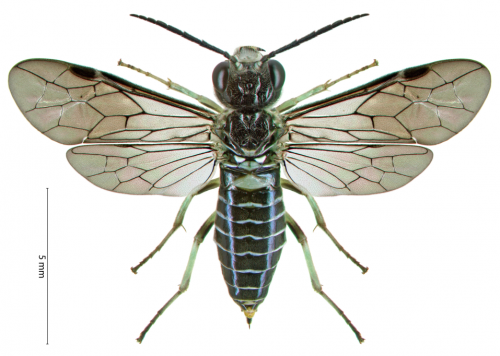What's on the menu for young African sawflies?

Sawflies belong to the same insect group as wasps, bees and ants. Unlike many of the latter, sawflies seldom make themselves conspicuous to humans, although the young stages (larvae) of some species, nearly all of which feed on plants, sometimes attract attention by damaging these.
In a reversal of the pattern found in most insect groups, a larger number of sawfly species occur in regions with a cooler climate, rather than in the tropics. On the other hand, many of the sawflies found in Africa south of the Sahara (the Afrotropical faunal region) belong to genera that occur nowhere else in the world.
In Europe much more is known about the habits of sawfly larvae than in most other parts of the world. This knowledge has been built up since the 18th Century, with a very significant contribution from amateur entomologists. By contrast, extremely little is known about the early stages of sawfly species in the Afrotropical region.
One of the distinctive and relatively species-rich groups of Afrotropical sawflies is the genus Xenapates, with 47 known species. Although two of the commonest and most widely distributed Xenapates species (X. braunsi and X. gaullei) were first described by the German amateur scientist Friedrich Wilhelm Konow in 1896, nothing was known until now about their early stages, seasonal occurrence (phenology), or even which plants these feed on.
Dr Georg Goergen (International Institute of Tropical Agriculture, Cotonou, Benin) discovered the early stages of X. braunsi and X. gaullei and in cooperation with Dr Frank Koch (Museum fuer Naturkunde, Berlin, Germany) and Andrew Liston (Senckenberg Deutsches Entomologisches Institut, Muencheberg, Germany) studied their morphology (physical appearance) and habits.

The results include information on the plant species fed on by the larvae. X. braunsi uses a number of grass species as hosts, some of which are of importance in African agriculture. One of these, but apparently not amongst the most frequently eaten, is maize. X. braunsi is so far the only sawfly known to feed on this important crop plant. Larvae of X. gaullei feed on a genus of plants called day flowers, related to the grasses. Some day flower species are invasive weeds in North America and Europe, and X. gaullei warrants further study as a possible agent in combatting these.
More information: Liston A, Goergen G, Koch F (2015) The immature stages and biology of two Xenapates species in West Africa (Hymenoptera, Tenthredinidae). Deutsche Entomologische Zeitschrift 62(1): 9-17. DOI: 10.3897/dez.62.8922
Provided by Pensoft Publishers





















